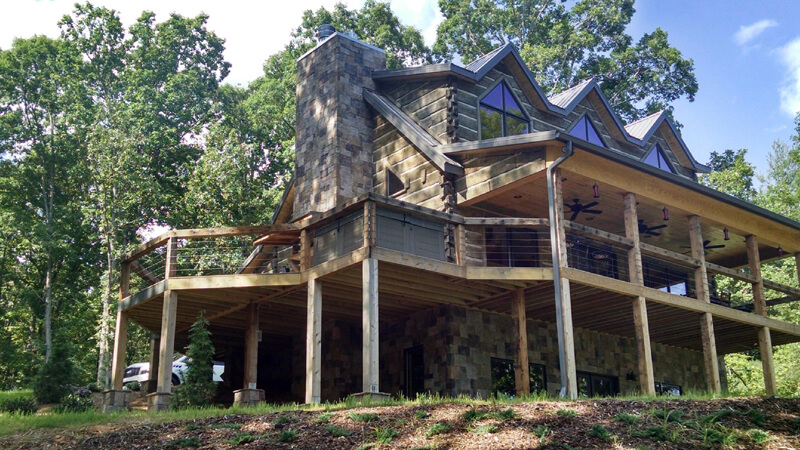Wilmington Faux Log Siding Exteriors can add a touch of rustic charm to any home’s exterior. Whether you live in a country cabin or a modern suburban house, faux log siding can provide the look of real wood without the high maintenance and cost. In this article, we will explore the different aspects of faux log siding, from understanding its basics to its installation process and maintenance requirements.
Understanding Faux Log Siding
Before diving into the benefits and installation process, it’s important to grasp the basics of faux log siding. Essentially, it is a synthetic material made to resemble real wood logs. However, faux log siding offers more versatility and durability than traditional wood. It is typically made from vinyl or concrete, each with its own set of advantages.
The Basics of Faux Log Siding
Vinyl log siding is a popular choice due to its low cost and easy installation. It mimics the appearance of wood with realistic grain patterns and textures. On the other hand, concrete log siding offers superior durability and resistance to pests, fire, and weather conditions. It can withstand harsh elements and is an excellent long-term investment.
When it comes to vinyl faux log siding, homeowners can enjoy a wide range of color options to suit their preferences and home aesthetics. From warm cedar tones to rich walnut hues, vinyl siding can be customized to complement any architectural style. Additionally, vinyl is a lightweight material, making it easier to handle during installation and reducing strain on the structure of the house.
Concrete faux log siding, on the other hand, provides a rugged and authentic look that adds character to any home. Its robust nature makes it ideal for areas prone to extreme weather conditions, such as heavy snowfall or intense heat. Concrete siding can also be molded and textured to closely resemble natural wood, giving homeowners the best of both worlds in terms of aesthetics and durability.
Benefits of Choosing Faux Log Siding
Opting for faux log siding comes with several benefits. First and foremost, it offers the aesthetic appeal of natural wood logs without the hassle of regular maintenance. Faux log siding is also resistant to rot, warping, and insect damage, ensuring its longevity. Additionally, it provides excellent insulation, reducing energy costs and creating a comfortable living environment.
Different Types of Faux Log Siding
When deciding on faux log siding for your home, it’s important to consider the different types available. Vinyl log siding is a popular choice due to its affordability and ease of installation. It comes in a variety of colors and finishes, allowing homeowners to achieve their desired look. Meanwhile, concrete log siding offers unmatched durability and can withstand extreme weather conditions.
Vinyl Log Siding
Vinyl log siding is lightweight and easy to handle, making it a favorite among DIY enthusiasts. It requires minimal maintenance, typically just an occasional cleaning with mild soap and water. Its versatility allows homeowners to experiment with different styles, from traditional log cabin aesthetics to more contemporary designs.
Concrete Log Siding
Concrete log siding is known for its exceptional durability and longevity. It provides excellent protection against pests, fire, and severe weather conditions. While concrete log siding may require professional installation due to its weight and specialized tools, it offers a realistic wood appearance that can last for decades with minimal maintenance.
Installation Process of Faux Log Siding
Installing faux log siding may seem daunting, but with proper preparation and guidance, it can be a manageable project. Before you begin, it’s crucial to properly prepare the area and gather all the necessary tools and materials.
Preparing for Installation
Prior to installing faux log siding, ensure that the surface is clean, dry, and free from debris. Properly inspect the walls for any structural imperfections or rot that may need to be addressed before installation. It’s also important to measure and plan accordingly to avoid unnecessary waste or mismatched seams.
Step-by-Step Guide to Installation
- Start by applying a vapor barrier or insulation board to the exterior walls to provide additional insulation and protect against moisture.
- Install furring strips horizontally along the walls, ensuring they are level and properly spaced.
- Begin attaching the faux log siding panels to the furring strips, starting from the bottom and working your way up.
- Secure each panel with the appropriate fasteners, following the manufacturer’s guidelines.
- Trim the siding as necessary to ensure a proper fit around windows, doors, and corners.
- Repeat the process until the entire area is covered, ensuring that each panel is properly aligned and securely attached.
- Finally, inspect the installation for any gaps or loose panels and make the necessary adjustments.
Maintenance and Care for Faux Log Siding
Although faux log siding is relatively low maintenance compared to real wood, it still requires regular care to ensure its longevity and visual appeal. By following a few simple cleaning and upkeep tips, you can keep your faux log siding looking its best for years to come.
Cleaning and Upkeep Tips
To clean your faux log siding, simply use a pressure washer or hose to remove any dirt or debris. Avoid using abrasive cleaners or harsh chemicals, as they can damage the surface. Additionally, ensure that any vegetation near the siding is trimmed to prevent moisture buildup and potential damage.
Long-Term Maintenance Strategies
Regularly inspect your faux log siding for any signs of wear or damage. Replace any cracked or broken panels promptly to prevent further issues. It’s also recommended to apply a fresh coat of paint or sealant every few years to maintain its appearance and protect against fading or peeling.
Cost Considerations for Faux Log Siding
When considering faux log siding for your home, it’s important to factor in both the initial investment and ongoing maintenance costs.
Initial Investment and Installation Costs
The cost of faux log siding varies depending on the material and quality. Vinyl log siding is generally more affordable, with prices ranging from $3 to $8 per square foot. Concrete log siding, being more durable and long-lasting, tends to be higher in price, ranging from $6 to $15 per square foot. Installation costs also vary and may require professional assistance, particularly for concrete log siding.
Ongoing Maintenance Costs
One of the significant advantages of faux log siding is its minimal ongoing maintenance requirements. While occasional cleaning and inspections are necessary, faux log siding does not require the regular staining, sealing, and repainting associated with real wood. This can result in significant cost savings over time.
In conclusion, Wilmington Faux Log Siding Exteriors offer homeowners the opportunity to enhance their home’s exterior with the timeless appeal of log cabin aesthetics. Understanding the basics, different types, installation process, and maintenance requirements can help you make an informed decision and ensure that your faux log siding continues to enhance your home’s beauty for years to come.
Transform Your Home with Smart Logs of the Carolinas
Ready to elevate your home’s exterior with the durability and charm of concrete log siding? Smart Logs of the Carolinas offers the perfect blend of beauty and resilience, ensuring your home stands out with the timeless appeal of hand-hewed logs. Our environmentally friendly concrete logs are not only competitively priced but also boast superior resistance to insects, weather, and wear. Plus, they’re energy-efficient, low maintenance, and easy to install on new or existing structures. Embrace the cost-effective, fire-resistant, and rot-resistant solution for your dream home. Don’t wait to start your journey towards a stunning, long-lasting exterior. Contact Us! today at 828.781.2015 or email us at info@mysmartlogs.com for more information.

